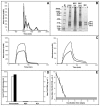Next generation inactivated polio vaccine manufacturing to support post polio-eradication biosafety goals
- PMID: 24349497
- PMCID: PMC3861478
- DOI: 10.1371/journal.pone.0083374
Next generation inactivated polio vaccine manufacturing to support post polio-eradication biosafety goals
Abstract
Worldwide efforts to eradicate polio caused a tipping point in polio vaccination strategies. A switch from the oral polio vaccine, which can cause circulating and virulent vaccine derived polioviruses, to inactivated polio vaccines (IPV) is scheduled. Moreover, a manufacturing process, using attenuated virus strains instead of wild-type polioviruses, is demanded to enhance worldwide production of IPV, especially in low- and middle income countries. Therefore, development of an IPV from attenuated (Sabin) poliovirus strains (sIPV) was pursued. Starting from the current IPV production process based on wild type Salk strains, adaptations, such as lower virus cultivation temperature, were implemented. sIPV was produced at industrial scale followed by formulation of both plain and aluminium adjuvanted sIPV. The final products met the quality criteria, were immunogenic in rats, showed no toxicity in rabbits and could be released for testing in the clinic. Concluding, sIPV was developed to manufacturing scale. The technology can be transferred worldwide to support post polio-eradication biosafety goals.
Conflict of interest statement
Figures





Similar articles
-
Differences in Antigenic Structure of Inactivated Polio Vaccines Made From Sabin Live-Attenuated and Wild-Type Poliovirus Strains: Impact on Vaccine Potency Assays.J Infect Dis. 2020 Feb 3;221(4):544-552. doi: 10.1093/infdis/jiz076. J Infect Dis. 2020. PMID: 30788503
-
sIPV process development for costs reduction.Vaccine. 2015 Aug 20;33(35):4307-12. doi: 10.1016/j.vaccine.2015.03.076. Epub 2015 Apr 6. Vaccine. 2015. PMID: 25858858
-
Sabin inactivated polio vaccine upstream process development using fixed-bed bioreactor technology.Vaccine. 2025 Apr 19;53:126950. doi: 10.1016/j.vaccine.2025.126950. Epub 2025 Mar 3. Vaccine. 2025. PMID: 40037128 Free PMC article.
-
Current and next-generation formulation strategies for inactivated polio vaccines to lower costs, increase coverage, and facilitate polio eradication.Hum Vaccin Immunother. 2022 Dec 30;18(7):2154100. doi: 10.1080/21645515.2022.2154100. Epub 2022 Dec 28. Hum Vaccin Immunother. 2022. PMID: 36576132 Free PMC article. Review.
-
Clinical development of a novel inactivated poliomyelitis vaccine based on attenuated Sabin poliovirus strains.Expert Rev Vaccines. 2011 May;10(5):635-44. doi: 10.1586/erv.11.51. Expert Rev Vaccines. 2011. PMID: 21604984 Review.
Cited by
-
Hematopoietic cancer cell lines can support replication of Sabin poliovirus type 1.Biomed Res Int. 2015;2015:358462. doi: 10.1155/2015/358462. Epub 2015 Feb 28. Biomed Res Int. 2015. PMID: 25815312 Free PMC article.
-
Vero cell upstream bioprocess development for the production of viral vectors and vaccines.Biotechnol Adv. 2020 Nov 15;44:107608. doi: 10.1016/j.biotechadv.2020.107608. Epub 2020 Aug 5. Biotechnol Adv. 2020. PMID: 32768520 Free PMC article. Review.
-
A polyvalent inactivated rhinovirus vaccine is broadly immunogenic in rhesus macaques.Nat Commun. 2016 Sep 22;7:12838. doi: 10.1038/ncomms12838. Nat Commun. 2016. PMID: 27653379 Free PMC article.
-
Development of an animal component free production process for Sabin inactivated polio vaccine.Vaccine X. 2022 Sep 30;12:100223. doi: 10.1016/j.jvacx.2022.100223. eCollection 2022 Dec. Vaccine X. 2022. PMID: 36217423 Free PMC article.
-
Current trends in West Nile virus vaccine development.Expert Rev Vaccines. 2014 May;13(5):589-608. doi: 10.1586/14760584.2014.906309. Epub 2014 Apr 1. Expert Rev Vaccines. 2014. PMID: 24689659 Free PMC article. Review.
References
-
- Bakker WAM, Thomassen YE, van’t Oever AG, Westdijk J, van Oijen MGCT et al. (2011) Inactivated Polio Vaccine development for technology transfer using attenuated Sabin poliovirus strains to shift from Salk-IPV to Sabin-IPV. Vaccine 29: 7188-7196. doi:10.1016/j.vaccine.2011.05.079. PubMed: 21651934. - DOI - PubMed
-
- Sabin AB, Boulger LR (1973) History of Sabin attenuated poliovirus oral live vaccine strains. J Biol Stand 1: 115-118. doi:10.1016/0092-1157(73)90048-6. - DOI
-
- WHO (2002) Recommendations for the production and control of poliomyelitis vaccine (inactivated) Technical Report Series No. 910 World Health Organization.
Publication types
MeSH terms
Substances
LinkOut - more resources
Full Text Sources
Other Literature Sources
Medical
Molecular Biology Databases
Miscellaneous

